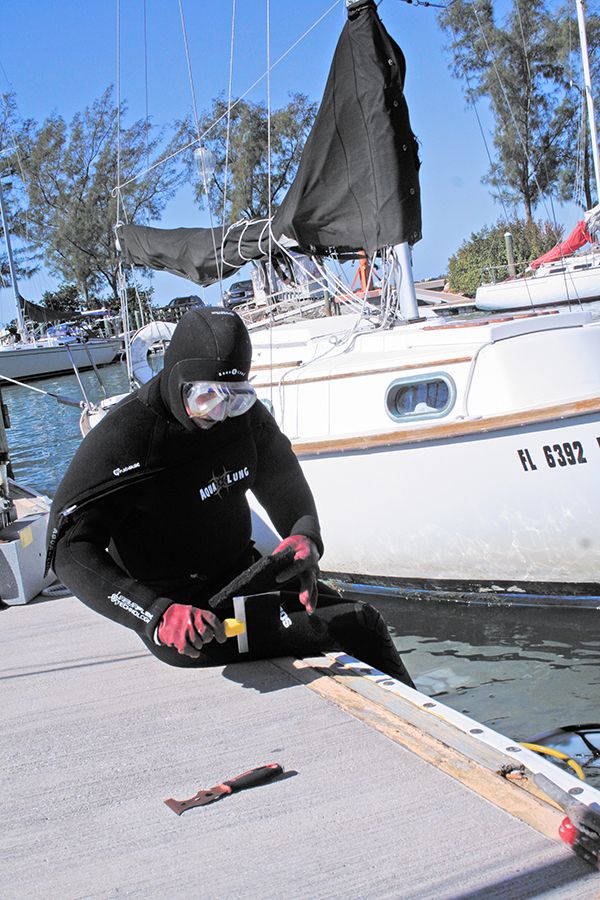
At some point in your cruising life, it is likely you will have to go into the water to deal with a rope, line, or net that has wrapped around your prop.
The first indication of a snagged line is often a sudden and pronouced increase in noise and vibration in the engine room. The typical first response after putting the boat in neutral is to check the shaft coupling. These have been known to work loose.
If there’s no problem with the coupling or engine mounts (another common cause of excessive vibration), the prop becomes a suspect. If an inspection—camera or visual— shows a rope around the prop, you should try to remove it before it jams farther around the shaft, or damages the cutless bearing.
We’ve been able to use a hook-shaped cutter attached to a boat hook to cut away discarded fishing gear from the deck. But on other occasions, we’ve had to take the plunge. Before going in the water to address any underwater problem, you need to take certain precautions.
At the Dock
- Lock the prop, and/or take other measures to prevent the engine from accidentally starting. Keys must be out of the ignition.
- Electrical Shock Drowning (ESD).This is primarily a freshwater problem caused by wiring leaks. Even a tiny electrical field can paralyze swimming muscles and cause rapid drowning. In freshwater, do not dive at the dock; move at least 200 feet away from all power sources. In seawater it is probably sufficient to unplug your boat, and if possible, all neighboring boat (see “Preventing Electric Shock at the Dock,” Practical Sailor, August 2019).
Anchored, Moored, or Underway
- Stop, obviously. Adjust heading to calm the waters in the dive zone by heaving to or streaming a sea anchor. Drifting is generally better than anchoring if there is sea room. Pitching can result in the boat slamming against the swimmer; a helmet may help, but most provide too much flotation and snagging is a risk.
- Strong swimmer’s only. This is not just splashing at the pool. Even at the dock there will be a lot of treading water and breath-holding involved. It is possible to become snagged. Underway there will be waves, so experience snorkeling and swimming in surf is mandatory.
- Dress for the water temperature. No amount of gritting you teeth is safe below about 68F. A wet suit is better for swimming, but a dry suit works well if you get ALL of the air out (the final seal must be made in the water).
- Minimize snag potential. All clothing must be snug. Do NOT put tools on wrist lanyards if free diving; it is far better to drop a knife than to snag your wrist on the prop. Work in shallow water, or tie lanyards to the boat—not the wrist.
- Take your time. It is possible to pass out during extended breath holding underwater, and the combination of treading water and working hard can challenge the strongest swimmer. If you are out of breath, take a break. Dangling a flotation aid in the water for rest is a good idea.
- Don’t tie a safety line to the diver. It is far too easy for it to become snagged.
- Do trail a safety line in the water. A Lifesling is very good for this. If the sailor drifts away and the boat is disabled, recovery will be difficult.
- Like much of sailing, judgment is required. Consider all of the variables, the seriousness of the need, and know your limitations. We’ve had to replace a prop while underway offshore, but we had enough time to plan. With patience and good planning, much is possible, and everyone will be safer. Never rush.




































